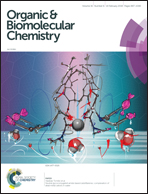Neutral glycoconjugated amide-based calix[4]arenes: complexation of alkali metal cations in water†
Abstract
Cation complexation in water presents a unique challenge in calixarene chemistry, mostly due to the fact that a vast majority of calixarene-based cation receptors is not soluble in water or their solubility has been achieved by introducing functionalities capable of (de)protonation. Such an approach inevitably involves the presence of counterions which compete with target cations for the calixarene binding site, and also rather often requires the use of ion-containing buffer solutions in order to control the pH. Herein we devised a new strategy towards the solution of this problem, based on introducing carbohydrate units at the lower or upper rim of calix[4]arenes which comprise efficient cation binding sites. In this context, we prepared neutral, water-soluble receptors with secondary or tertiary amide coordinating groups, and studied their complexation with alkali metal cations in aqueous and methanol (for the comparison purpose) solutions. Complexation thermodynamics was quantitatively characterized by UV spectrometry and isothermal titration calorimetry, revealing that one of the prepared tertiary amide derivatives is capable of remarkably efficient (log K ≈ 5) and selective binding of sodium cations among alkali metal cations in water. Given the ease of the synthetic procedure used, and thus the variety of accessible analogues, this study can serve as a platform for the development of reagents for diverse purposes in aqueous media.
![Graphical abstract: Neutral glycoconjugated amide-based calix[4]arenes: complexation of alkali metal cations in water](/en/Image/Get?imageInfo.ImageType=GA&imageInfo.ImageIdentifier.ManuscriptID=C7OB02955A&imageInfo.ImageIdentifier.Year=2018)
- This article is part of the themed collection: Supramolecular chemistry in OBC


 Please wait while we load your content...
Please wait while we load your content...